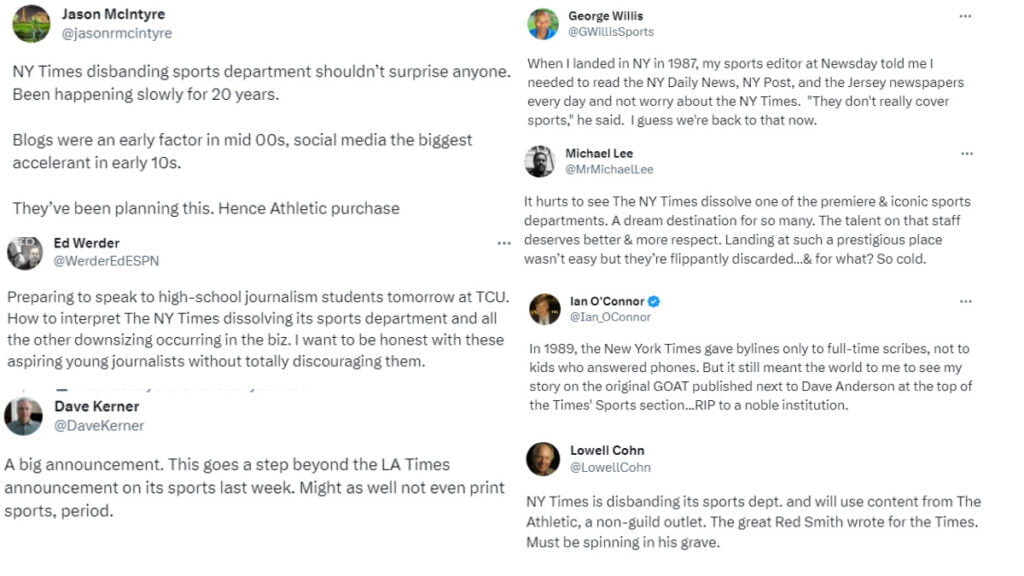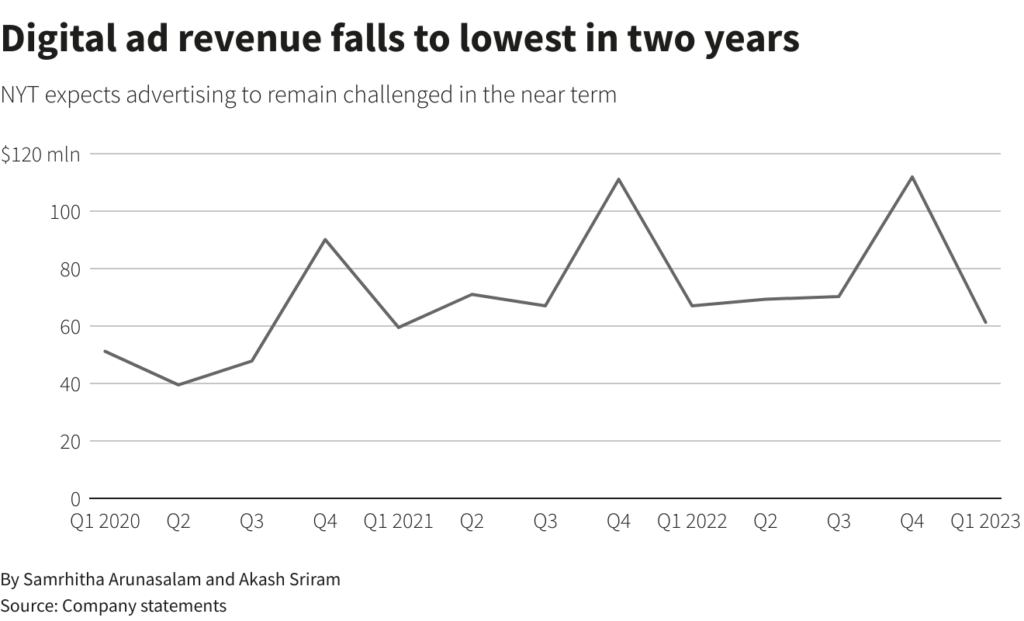Call me asleep at the wheel, out of touch or an aging broadcaster who has it all wrong, but I firmly believe that people still like to read. I know the popular thing is to talk up video, audio, streaming, etc., and I love all of those options, but I don’t buy that people don’t have time or interest in reading.
For many, especially in the media business, it’s how you start and end your day. I’ve heard people pronounce last rites for print for well over a decade, only to see social platforms and media outlets thrive off the written word, newsletters rapidly rise, and text become the main form of communicating. Clearly, written content still matters.
It’s ironic that I’m telling you this in print as you read it on the BSM website. In fact, more than nine million visitors have stopped by this site over the past three years, reinforcing why I remain convinced people value learning and enjoying a mental distraction.
As much as I love audio and video, there’s something therapeutic about reading a story. There are thousands of shows flooding the daily content cycle, many discussing the same topics and issues. Some could say the same exists in print, but there are countless examples of in-depth storytelling and reporting that can’t be duplicated on radio, TV or even in a podcast.
Think for a second about the majority of sports information that people react to each day. It comes in written form. If you’re an NBA fan, you rely on tweets from Woj and Shams. If you crave the NFL, Schefty and Rapoport keep you informed. Even those seeking sports media news get it from Marchand, McCarthy, Ourand, and BSM. Whether it’s delivered in a tweet or an online article, the bottom line, you’re reading it.
Though I remain bullish on the power of print, I’m not naive to the fact that the business has been challenged. If the revenue or costs don’t produce positive results for a company, they are going to do whatever is necessary to strengthen their business.
Recently, the New York Times chose to throw in the towel on its local sports department, relying instead on The Athletic for its local sports coverage needs. It was a decision undoubtedly influenced by dollars and cents. As expected, many in the media took exception.

In a statement issued to the Times’s newsroom, the newspaper’s executive editor, and deputy managing editor emphasized that the changes would result in more direct focus on distinctive, high-impact news and enterprise journalism about how sports intersect with money, power, culture, politics and society at large. What they felt no longer needed attention was coverage of games, players, teams and leagues.
Interesting. This follows the Los Angeles Times recent decision to remove box scores, game stories, standings, and TV listings. These are things that sports fans have cared about and paid attention to for decades.
These two newspapers believe your interest in knowing the details of a game, and how your favorite team is performing compared to others, no longer matter. Either that’s the viewpoint or they’ve waved the white flag and determined people would rather go to ESPN, Yahoo and other online destination for that information. It’s easy to see why these decisions drew the ire of Adam Schein on SiriusXM’s Mad Dog Sports Radio and Jessica Benson on Grind City Media.
I don’t believe people who love sports don’t care about the things the Times is eliminating. Maybe interest in those items is lower when compared to news and in-depth storytelling but sports fans have always had interest in statistics, schedules, transactions, and standings. To suggest they don’t matter anymore is foolish.
You can debate if the newspaper’s vision for covering sports is right for the future or not but what made this situation worse is the way their executive team managed the situation with the sports staff.
It was reported that employees sent a letter to management the day prior, asking for clarity on the future of their department. Though the Times said in a letter to staff that no plans existed for layoffs, they ignored the fact that The Athletic had 20 staff members eliminated last month, and 20 more transferred to other roles. The transfer approach was also their solution for the sports department, hoping moving staffers to another department would help avoid the wrath and a bigger fight with their union.
But when news trickles in from the outside that plans are in the works to eliminate a department, and those skilled at covering sports are offered roles that remove them from what they enjoy doing, why would they stay? If someone took away your sports job and told you you’d continue being paid but now have to write obituaries, what would you do? Some will see this as creating a structure that encourages people to quit. That’s one way to eliminate costs without being on the hook for breaking a promise to not eliminate jobs.
Though I think the management team at the Times has royally screwed up their handling of this situation, let’s remove emotion for a second, and look at this from a business perspective.
The New York Times’s parent company started this process in January 2022 when it invested five hundred and fifty million dollars in The Athletic. Were they not supposed to prioritize the sports brand they purchased? Were they supposed to continue funding two operations with the same content focus even if it meant losing money?
One could argue that the newspaper could’ve moved its best sports writers to The Athletic, but to expect both to operate as is isn’t realistic. You can also criticize the decision to stick with The Athletic after the brand lost $7.8 million last quarter, $12.6 million in the second quarter last year, and $6.8 million in February and March of 2022 despite having 3.3 million subscribers. By the way, that information was shared by the New York Times in public filings.
Love it or hate it, when a company has resources tied up in two places for the same thing, you can rest assured they’re going to eliminate or reduce one of them. The changes don’t happen right away either, they usually come a year or two later.
This isn’t exclusive to the print industry. Look at what happened to the pro wrestling business when Vince McMahon acquired WCW from Turner. He didn’t run two companies long term. He kept who he wanted, dropped the others, and a lot of people in that business were left without work. It happens in radio too when a station eliminates local shows for national programming or companies take over a new market or entire organization. You may not love hearing executives talk about finding ‘synergies’ to operate more efficiently, but they’re not going to pay twice for something that requires one investment.
When cuts are made and a department is weakened, it’s hard to express enthusiasm. Why would one be optimistic about the Times’s ability to cover the world of sports when they have less of a presence, and are minimizing coverage of games, players, teams, and leagues? If you’re at the New York Daily News, New York Post or Newsday you’re using the moment to remind New Yorkers that you remain committed to local sports coverage with a locally focused staff.
It’s more than fair to question if this the Times is making a smart decision, but for anyone to suggest this confirms a lack of interest in reading and sports coverage is foolish. These decisions are always about one thing, and one thing only, money.
The bigger issue with print isn’t a lack of interest. It’s the cost to employ and retain a talented staff while grappling with the challenges of generating advertising and subscription revenue. Think the fact that the sports desk at the Times was unionized, and The Athletic was not might’ve mattered in this case? You’re nuts if you think it didn’t.
In May of this year, the New York Times missed estimates for quarterly revenue. That led to a 6% drop in their stock price at the time. The Times said they expected digital ad revenue to decline by low-to mid-single digits, which was confirmed when they revealed they were nearly 9% down in digital ad revenue for the first quarter, and off by 11 million dollars for total annual revenue.

As a publisher myself, I know how hard it is. We are fortunate to have some excellent, loyal advertising partners on this website but truth be told, we don’t have enough of them. More months than most we spend more than we take in to run our websites, and newsletters. Consulting remains our top source for revenue, leaving me to ask many times if modifying our content approach is needed or if we’d be wiser running a business without an online focus.
We put a ton of time and effort into educating the industry. I take great pride covering brands and people, telling their stories, trying to help folks learn about each other and the daily happenings across the media landscape. We pump out 30-40 stories each day between our two websites, promote them across social media, and deliver them to more than 10,000 inboxes via our BSM 8@8 and BNM Rundown. And that’s just the content side.
We also spend countless hours creating packages, pursuing new business, and taking meetings to demonstrate our reach and value in order to gain advertising support. We build conferences across the country, and risk a lot financially to do them, hoping to earn enough to cover the expenses and get many of the right industry people in the room. But even that can be difficult. For every partner we gain, there are many who don’t come on board. Most who do have seen the benefits, but I understand that a weakened economy makes decision makers nervous.
That said, if this site disappeared tomorrow, many would be upset. We’ve earned trust, respect, and appreciation for the work we do from a lot of important people. But in every business, if the support isn’t there, the publisher, brand or company has to choose what is and isn’t vital to operating. Folks may not like change, but it’s simply about the math. If the dollars and cents don’t add up, you’ve got to adjust or you risk being broke or out of business.
That’s what I believe this decision at the New York Times is about. You can take issue with their vision and the way they managed the situation but understand that an investment in The Athletic makes no sense if the Times isn’t prepared to prioritize its importance. You can question if they should’ve purchased The Athletic in the first place, but once that move was made, it was only a matter of time until something this drastic occurred.
But those who flocked to social media to suggest this is proof of people not being interested in reading are wrong. Each time I hear nonsense uttered about print being dead, I think of how often the same has been said about radio and television. I think about the film industry, which relies on written scripts, and in many cases, published books to create box office hits. I think of Canada pulling its advertising support from Facebook and Instagram over parent company Meta’s decision to restrict news content being available to Canadians. I think of our own growth at BSM and BNM, which is a result of people consuming our written content either online, on social media or in newsletters.
Interest in reading, learning, and mentally escaping from the world for a few is as strong as ever. We live on social media apps and our phones because we want to read what others say, and join the conversation. It all reinforces the notion that consuming written content matters, whether it’s on a website, on social media, in a text, in a newspaper, newsletter or magazine.
The only questions anyone should be asking is what must digital/print brands do to attract stronger advertising dollars, how much investment must a company make to deliver quality journalism and a large audience, and how much consolidation awaits the media world in the near and distant future? We can scream from the mountaintops all day about the decline of journalism and rip the New York Times for decimating its local sports department, but if the dough don’t show, someone or something is going to go.

Jason Barrett is the Founder and CEO of Barrett Media. The company launched in September 2015 and has provided consulting services to America’s top audio and video brands, while simultaneously covering the media industry at BarrettMedia.com, becoming a daily destination for media professionals. Prior to Barrett Media, Jason built and programmed 95.7 The Game in San Francisco, and 101 ESPN in St. Louis. He was also the first sports programmer for SportsTalk 950 in Philadelphia, which later became 97.5 The Fanatic. Barrett also led 590 The Fan KFNS in St. Louis, and ESPN 1340/1390 in Poughkeepsie, NY, and worked on-air and behind the scenes at 101.5 WPDH, WTBQ 1110AM, and WPYX 106.5. He also spent two years at ESPN Radio in Bristol, CT producing ‘The Dan Patrick Show’ and ‘GameNight’. JB can be reached on Twitter @SportsRadioPD or by email at Jason@BarrettMedia.com.



